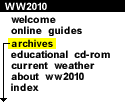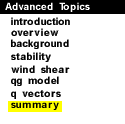
|
4. Summary and conclusions The following summary and questions can be gleaned form this study of the Veteran's day snowstorm of 1996:
- The severe snowfall in NE Ohio on the evening of 11/9/96 was
underpredicted by all NWP models, but shows up well in the diagnostic
analysis of the storm. In retrospect, the slowing down and tilt of the
upper longwave feature may have helped this system strengthen and hit
the brakes as it rotated into the eastern lakes. Q-vector analysis
from the QG model equations shows strong Q-vector forcing in the same
vicinity as the heaviest snowfall. This forcing indicates a frontolytic
transverse frontal circulation and may have given clues to both problems
in the predictive models. it is unclear from our analyses whether the
snowfall was lake-enhanced, but the high tallies of observed snow in the
Cleveland high-elevation snowbelts support this idea.
- The vertical structure of temperature within the quasistationary
longwave trough is highly anomalous. Very cold upper air temperatures
for early November combine with a strong shear zone well to the south
and west of the lakes to keep any NVA and sinking processes away from
the region. This results in three days of nearly pseudo-adiabatic
environments from the
surface to 500 Mb in many locations. This is an
excellent case study for determining the interaction between synoptic
dynamic processes and warm lake mesoscale circulation's, since any
forcing of the system will be efficiently communicated in the vertical
due to very low static stability's.
- The quiescent trough axis near the vortex center appears an ideal
breeding zone for lake effect snow storms in that nearly steady state
and weakly cyclonic flow can remain in place for long duration's.
- The QG model is not much aware of the lakes but some potentially
interesting omega and divergence patterns were found when looking in
cross-section along a predetermined trajectory from southern L. Michigan
through L. Erie. There were clear, but weak, ascent regions over and
downwind of these two lakes and there were weak convergence bands
coincident with the lakes.
- In terms of sensible weather, the diurnal production of widespread cell convection and possible interference with the lake bands' intensity and coverage is a baffling problem. This would likely only occur early in the season since the Benard convection requires reasonable surface radiative heating; moreover, the cellular convection should not be produced over the lake surface (at least with any diurnal signal). A possible scenario might be the advection of small cells into lake convergence and bandedness regions that upsets the mesoscale circulation within these snow bands.
In conclusion, the fine scale dynamic features induced by the lakes and the interaction between the lakes and the large scale dynamics should be more closely studied. This is potentially a fertile area of research, since the theoretical framework of interaction between the large-scale and lake effect circulations is quite incomplete; however, different tools for deducing these relationships would be needed since the QG theory is not well suited for diagnosing near surface processes and dynamics. Secondly, for a lake effect researcher, the diurnal variation of this storm is provocative. Links between overland cellular convection and weakening or disorganized band convection have not been explained previous to this case, and the author has no knowledge of the phenomenon being observed prior to this case.

Q Vectors |
|

Hurricane Andrew |



